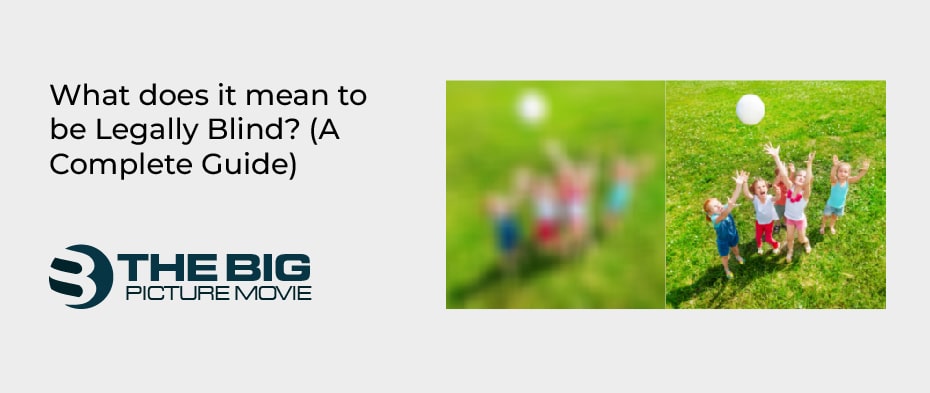
What does it mean to be Legally Blind? (A Complete Guide)
Sometimes people think that blindness and being legally blind are the same thing, which it is not. There is a difference between blind and officially blind, which is the threshold according to which you are visually impaired for lawful purposes. Such as getting certain benefits regarding jobs, insurance, or being conventional in several programs will be easy for that people.
According to the U.S. Social Security Administration, if someone gets disability benefits, low vision training, and tax exemptions, then he is lawfully blind. But actually, if your vision is weak and you can see quite well through glasses, you seem to be officially blind, not entirely blind. Hence, lawfully blind people cannot drive safely, so it is better to take treatment on time. Now, let’s move to the section to get a detailed guide regarding blindness.
Introduction to Legally Blind
Being lawfully blind is not like being completely blind. There is a difference between both these terms. Officially blind means you have some vision, whereas entirely blind means you have complete light and form perception; which is unfortunate who have eye disorders, about 80% have some sight, and another 15% are fully blind. There are two criteria; if you meet either one, it means you are lawfully blind. Thus, the requirements are visual acuity, which means sharpness of vision, and visual field, in which you can only see the entire scope without moving your eyes.
Visual Acuity
Basically, visual acuity refers to the distance at which you can see the object in detail. That is 20 feet. Normal vision defines as 20/20, whereas visual acuity defines as 20/80. It means that you can see in detail from 20 feet away, just as someone with 20/20 vision can observe from 80 feet away.
Thus, if you are officially blind, you can view an object at a distance of 20 feet with a vision 20/200 along with the corrective lenses; you can also see it from 200 feet away. Hence, visual acuity of 20/40 has low vision or worse as wearing corrective lenses.
Visual Field
Another criterion of being lawfully blind, as we introduced in the above section, is the visual field. If you have a visual field of 20o, then you can only see the things right in front of you without moving your eye from side to side, but you cannot see either side of anything. Having a visual field of 180o is refer as normal. Another condition is that if you face a severely limited visual field called tunnel vision, it is impossible to drive safely.
Diagnosis for Legally Blind
To analyze your eyesight, you have to visit an eye doctor. He will measure your visual acuity and visual field to determine whether you are lawfully blind or not. Hence, whether you can recover your vision by wearing glasses or contacts. Thus, there is a Snellen eye chart to test for visual acuity. Although, if you are officially blind, you can read the top line of the chart (from a to capital E) by wearing remedial lenses. However, the below line from the large E is the line for 20/100.
Moreover, some tests can determine 20/200 and 20/100 vision. If you cannot see the below line but can see between 20/100 and 20/200, you can meet the government’s legal standard of blindness, which is 20/200 or less.
A visual field test always starts with a confrontation in a visual field where the doctor covers one eye at a time. Then, he holds up one or more fingers in diverse quadrants to find out; if you can keep your eyes focused on a central point ahead in the visual field or not. Additionally, there is also a complete test that uses flash, flickering, moving lights, or pictures to compute your visual field. It involves pressing a button when the images or light appear.
Causes of Blindness
There are many causes that make you legally blind, but one of the most common is age-related. Cataracts (vagueness of the eye’s clear lens), glaucoma, diabetic retinopathy, and age-related macular degeneration are some of the other conditions. Moreover, injuries to the eye or genetic disorders like Usher syndrome may also be signs of legal blindness. But early diagnosis and treatment can prevent you from losing sight in many cases.
Treatment
Every treatment depends on the cause and stage of the disease, like the treatment of blindness. Normally, therapy for age-related eye diseases involves prescriptions or medicines and eye procedures to delay the worsening of vision. Similarly, in glaucoma disease, you have to avoid eye pressure, which can attain by eye drops, oral medicines, or laser. But in a severe case, you have to face the surgery to avoid further damage. In that case, you have to face surgery where the clouded lens will be removed or mostly replaced with an implant.
Prevention from Blindness
One of the best methods to prevent vision loss is to take care of your health. You should see your doctor on a regular basis, especially for eyes, which can alert your conditions that can impair your vision.90% of diabetes-related blindness is preventable, according to the U.S. Centers for Disease Control and Prevention.
Moreover, you have to maintain your weight and wear eye protection for particular activities. And also, get a healthy diet that is rich in fruits and vegetables. Another thing to safeguard yourself against diabetes-related vision loss is to control your blood sugar.
Final Words for Legally Blind Person
Careful monitoring is essential for an eye disease that helps prevent further damage. And also determine whether the treatment is effective or if you need to adjust. So, hopefully, the information above is helpful to you. Please let us know how effective it is for you. But remember to visit your eye doctor regularly to avoid damage.



![Craigslist SanDiego Real Estate [5 Tips to Use in 2023]](https://www.thebigpicturemovie.com/wp-content/uploads/2023/02/Craigslist-SanDiego.jpg)